U.S. Department of Transportation
Federal Highway Administration
1200 New Jersey Avenue, SE
Washington, DC 20590
202-366-4000
To gain maximum efficiency and effectiveness, incident response programs must have programmatic and institutional support at all levels. This programmatic and institutional support represents the strategic aspects of incident response and addresses how countries, organizations, and individuals approach the basic challenge of developing and coordinating incident response programs. The scan team learned of many examples in which various agencies or groups had made significant commitments to incident response and/or the larger challenge of incident management. The team found several with potential implementation value in the United States. This chapter describes the team's incident response recommendations related to programs and institutions.
In all four of the countries visited, the team observed a strong national commitment to incident response. Several countries had specific legislation or a national policy that established or contributed to the national emphasis on incident response. In England, for example, the Traffic Management Act of 2004 addresses several key areas of traffic management for added emphasis, including incident response issues.6 This act, key parts of which are summarized in Appendix D, gives the Highways Agency greater responsibility for responding to and clearing incidents. England is also developing the Fast Roads Manual (not yet available when this report was published), which describes response procedures and a national standard that defines the protection of workers responding to a traffic incident.7 This 28-page document provides guidance to workers assisting stranded motorists on the side of the road. In Germany, the Executive Order on Delay Management addresses several issues associated with trying to reduce the impacts of incidents.8
The Netherlands established an incident management program and achieved a 25 percent reduction in process time in 4 years. The Dutch also produced a traffic management manual9 and established a national policy on the order of priority for safely responding to an incident. These priorities are identified in table 8. As the list shows, Dutch responders make efforts to provide for their own safety and that of the other traffic moving through the incident site before taking action to assist incident victims. A video shown to the team during its visit to the Netherlands shows the first incident responders arriving at the scene of an incident. The video indicated that the first action taken by the initial responders was to set out cones to provide some level of protection for them while they attended to the vehicle and provided for a more orderly movement of traffic through the incident scene, improving the level of safety for traffic. The responders then approached the vehicles involved in the incident to assist the victims. The succeeding responders to the incident site provided a greater degree of traffic control through the site or diverted traffic to another route.
| Country | Safety Priorities |
|---|---|
| England |
|
| Netherlands |
|
The team also observed that some countries appear to devote significant resources to incident response activities. These activities are also tied to performance measures (discussed later). If the performance measures are not met, additional resources are committed until the performance targets are satisfied. In addition, the team saw examples of cost sharing between stakeholders. For example, in Sweden, the costs of supporting Trafik Stockholm are divided between the city and national road authority based on the number and location of incidents handled.
In the team members' opinion, the level of national commitment observed in several of the countries visited was a significant contributing factor to the success of the incident response programs in those countries. The team believes that a similar national commitment should be an important element of the overall traffic incident management program in the United States. To that end, the following is the team's recommendation on a national policy for incident response.
| Recommendation 1: National Unified Goal for Incident Response |
|---|
The United States should develop and adopt a national unified goal for incident response. The goal should address the following:
|
In each country, the team heard presentations by various groups involved in incident response activities in that country. The team was generally impressed by the familiarity of the presenters with one another even though typically they were from different organizations. It was apparent to the team that the various stakeholders involved in incident response in the four countries had close working relationships. In all four countries, incident responders typically included many of the stakeholders mentioned previously.
In England, the police are in charge at incidents. Highways Agency traffic officers are starting to provide traffic control assistance, and incident support units (provided by area maintenance contractors) assist the traffic officers. Emergency services are provided by fire and EMS responders. Removal and recovery are done under contract. Auto clubs and associations provide another layer of support for vehicles broken down on the shoulder. The activities of these responders are coordinated primarily through police dispatch centers, while distribution of motorist information is coordinated through a national traffic control center.
The Netherlands provided another excellent example of coordination among incident responders. The partners include police, EMS, fire, highway authority, recovery services, and the national auto club. The Dutch approach is to have coordinated, collective decisionmaking among the responders at the scene.
The team also found an excellent example of a unique working relationship in Germany. The Germans have an organization known as Technisches Hilfswerk (THW) that provides support services for long-duration incidents. These services may include units for electrical power, lighting, relief support, and logistical support such as food and other necessities. They may also provide support services to road users upstream of a long-duration incident trapped in the queue. THW and other support services for disaster and extended response rely on a remarkable system of volunteers coordinated between employers and the government. The government reimburses employers for employee wages when they are involved in response. This affords a quickly expandable response resource system.
The level of coordination between incident responders in the four host countries provides an excellent example for U.S. practice. While such cooperation does exist in many areas of the United States, the team believes that the responder relationships observed in Europe provide a good model for U.S. practices and the basis for the following recommendation.
| Recommendation 2: Incident Responder Relationships |
|---|
Incident responders should adopt formal working agreements. The formal agreements should do the following:
|
The team also observed that universities are integrated into the development and refinement of incident response programs. The team recognizes that U.S. researchers are involved in traffic incident management activities, but believes that such efforts can be improved. The team offers the following recommendation related to the relationship between practitioners and researchers.
| Recommendation 3: Integration of Practitioner and Research Perspectives |
|---|
Integrate the U.S. research network into incident response/management program development by establishing one or more Transportation Operations Centers of Excellence.
|
The team learned that performance measures are an important part of incident response programs in several areas and in several of the countries visited. The team observed performance measures in a variety of applications:
Perhaps the most common examples of performance measures were those used by auto clubs in England, Germany, and the Netherlands. EMS response time requirements are tailored on a region-by-region basis in Germany, accounting for urban and rural differences. Enforcement of these measures is not punitive, but may result in more resources being provided in areas where response times slip above the limits. Active and visible performance measurement of call centers or traffic management centers can drive customer awareness and improved service and responsiveness (England and the Netherlands). Germany and the Netherlands had incident auditors who go to an incident site and evaluate the effectiveness of the responders and their adherence to defined response protocols.
The team observed that performance measures serve a more integral role in incident response in the countries visited than they do in the United States. The team believes that performance measures could serve a beneficial role in U.S. incident response activities if properly implemented. Based on its observations, the team offers the recommendations below on performance measures.
The team learned that the countries visited have varying degrees of response time guidelines and requirements for EMS practices, but the guidelines and requirements are generally on a broader scale than in the United States (equivalent to a State or national scale versus an individual service or locale scale). In Germany, these guidelines are established on a district-by-district level though generally required by federal statute. The team believes that there is value in nationally facilitated and encouraged State or regional EMS response time guidelines and recommends that such guidelines be developed in the United States as described in Recommendation 4.
| Recommendation 4: Incident Response Performance Measures |
|---|
The United States should develop comprehensive national guidance on incident response performance measures that local and/or regional stakeholders can use to assess incident response programs:
The United States should evaluate the potential for using performance measures as a means of assessing the performance of private-sector incident response partners, including the following:
The United States should develop statewide guidelines based on national practices for EMS response time to traffic incidents:
|
The team found a strong commitment to training activities among responders in the countries visited. Of particular note was the extent to which response stakeholders participated in joint and coordinated training activities that included a specific focus on different incident response scenarios. In the Netherlands, all responders to traffic incidents are required to have at least first-aid training. This assures a more rapid response by personnel who know how to protect an injured patient from further injury and provide basic lifesaving care (e.g., stopping major bleeding, opening an airway).
Perhaps the best example of training demonstrated was at the Netherlands Institute for Fire Service and Disaster Management (NIBRA) facility near Arnhem. The team was shown a virtual training program known as the Advanced Disaster Management Simulator (ADMS™), which was developed to address the needs of first responders by training, testing, and validating emergency processes and procedures designed to prevent the loss of life and property. NIBRA selected a firm to develop and deliver comprehensive training programs that allow fire officers, incident managers, and other emergency response personnel to work together and train as an integrated team. The hosts invited team members representing fire, police, EMS, and departments of transportation to participate in a limited training scenario in which a tanker truck exploded on a freeway. Figure 4 illustrates two images from the training exercise.
Figure 4: Images from virtual training example
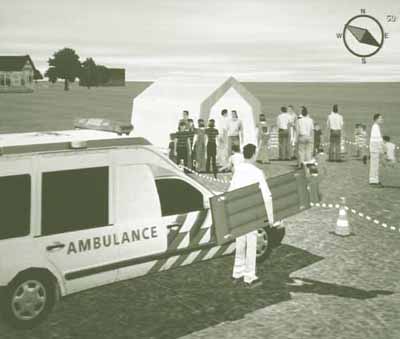
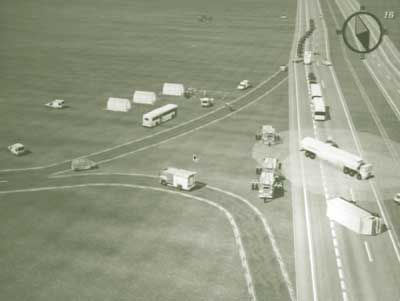
Based on the examples of integrated training activities observed in the host countries, the team believes that significant value would be realized from better integrating traffic incident response into first responder training. Accordingly, the team recommends the following.
| Recommendation 5: Incident Response Training |
|---|
Universal first responder training should focus more on traffic incident response, including the following:
|
In most of the countries visited, a large proportion of drivers belong to an auto club. In a majority of cases, the auto club responders are able to provide roadside vehicle repairs that allow motorists to continue their trip. The response vehicles often have the additional capability of towing vehicles for short distances off the motorway to a place of safety. Response times from these private motor clubs were short enough that the transportation agency service patrols did not have to concentrate on providing duplicate services.
As mentioned in the Chapter 2, automobile clubs play a significant role in England, Germany, and the Netherlands. In each country, the team learned how the auto club service patrols provide roadside assistance to vehicles that have broken down on the freeway. Although they are not the only auto clubs in the host countries, the team heard presentations from RAC Rescue (formerly the Royal Automobile Club) in England, Allgemeiner Deutscher Automobil Club (ADAC) in Germany, and Algemene Nederlandse Wielrijders Bond (ANWB) in the Netherlands. These organizations provide multiple services to club members, but the scan team's focus was on roadside assistance. The philosophy of the auto clubs is to repair a disabled vehicle whenever possible. In all three countries, the auto clubs succeed in getting vehicles back on the road some 82 to 90 percent of the time they dispatch a repair person. Accordingly, response vehicles are equipped to fix a wide range of malfunctions. Many response vehicles could also tow a disabled vehicle from the roadside to safe refuge area, from which a fully equipped tow vehicle could relocate the disabled vehicle to a repair facility. Figure 5 illustrates several of these vehicles. Typically, they carry a wide range of repair equipment, including gasoline, replacement batteries, fuses, water, oil, and sometimes a computer that can be connected to the vehicle to diagnose problems. In the Netherlands, the team observed a wide range of service vehicles, including vehicles for assisting passenger vehicles, a motorcycle that provides quick assistance in congested conditions, vehicles equipped to assist heavy vehicles, and a variety of towing vehicles.
Figure 5: Auto club service vehicles
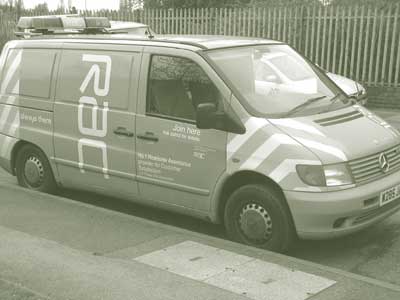
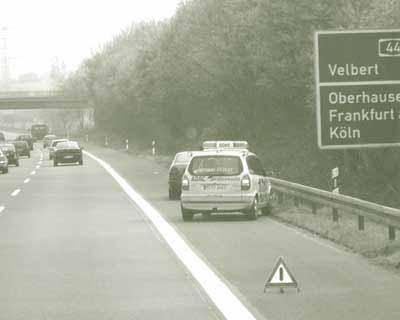
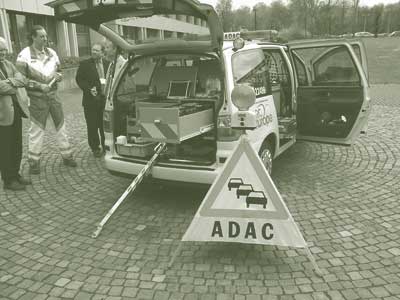
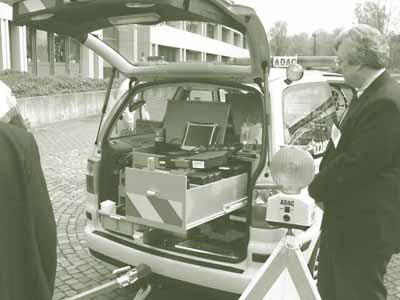
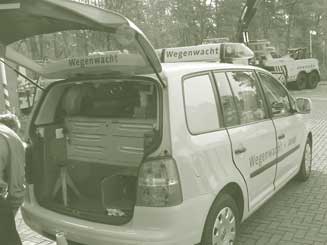
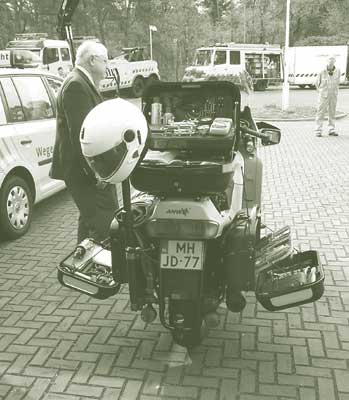
The team learned that the annual cost of belonging to an auto club was in the US$65-to-$100 range. The annual membership fee is significantly less than the mandatory tow fee imposed by the national authority when a vehicle breaks down on a freeway and the driver is not a member of an auto club. Furthermore, the labor associated with the repair assistance provided by the auto clubs is free.
In England and the Netherlands, the team visited an auto club operations center, from which service vehicles are dispatched to assist members with disabled vehicles. The auto clubs had advanced call centers and dispatch operations that allow for rapid response. They also had technical libraries with repair manuals from various manufacturers.
The private sector played an important role in incident response efforts in several countries. Examples include auto clubs in England, Germany, and the Netherlands, incident support units in England, and towing and recovery services in England and the Netherlands. The team believes that the private sector should play a greater role in assisting motorists in the United States and recommends the following.
| Recommendation 6: Private-Sector Role |
|---|
NTIMC or other stakeholders should conduct exploratory discussions with appropriate private-sector organizations to identify ways they could assume a greater role in the quick clearance of incidents and free responder agencies to focus on other responsibilities, such as traffic control at the incident scene.
|
| << Previous | Contents | Next >> |